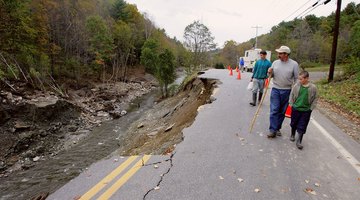How to Construct a Box Culvert Bridge
When streams, drainage areas and overflow ditches cross paths with driveways, small roads or embankments, a box culvert bridge is one practical and long-lasting solution to the problem. A culvert is just a fancy name for a channel through which water flows.

Things You Will Need
- Safety glasses
- Leather gloves
- Framing square
- Carpenter's pencil or permanent marker
- Pick
- Shovels (flat & pointed)
- Claw hammer (heavy)
- Tractor with backhoe attachment
- Trailer, 12- or 16-foot
- Air nailer
- 16d common and stick nails
- 14 to 16 pressure treated 5-by-5 timbers, x 12 feet
- 2 pressure treated 2-by-6s, x 12 feet
- 15 pressure treated 2-by-4s, x 12 feet
- 60 to 72 timber spikes, 6-inch
- Power saw
- Table saw (optional)
- Hand saw
A box culvert bridge gets its name simply because it is shaped like a box. The bridge part? If it's wider than 20 feet, the federal government designates it a "bridge" so that it is sure to get inspected regularly. Your box culvert can be any size you want.
-
Excavate for your bridge assembly with a backhoe; finish-up work can be done with shovels. If the bottom of the excavation is soft and muddy, you may need to excavate 6 inches deeper than required and add crushed rock or gravel to get a good base. It all depends on what type of traffic you are anticipating. For normal residential, rural or suburban drives, extra heavy duty construction is not required.
-
Put on safety glasses and protective leather gloves.
-
Construct one of the side panel assemblies by first deciding how many 5-by-5 timbers you will need on each stack. Measure from the top of the drive surface to the bottom of where the drainage will be. Cut six pressure treated 2-by-4s the same length as the stack height and make two panel assemblies. Keep the ends of the timbers -- which all should be the same length -- square.
-
Standing the side assemblies on edge, add the six top 5-by-5 timber cross members, which have been cut to 3 feet, 2 inches long. Predrill holes and nail these in place with timber spikes. Add the 2-by-6s, ripped to 5 inches wide, for blocking between the top 5-by-5 cross members. Turn the assembly upside down and add the six bottom 2-by-4s.
-
Have the top of the bridge assembly facing up again, and add the top deck using 9 or 10 2-by-4w that are 12 feet long. Set the heads of all nails on this deck below the surface using a pin punch or piece of bar steel. This completes the assembly of the box culvert bridge.
-
Haul the bridge assembly to the site and off load it into the previously made excavation. If you have access to a tractor with a front end loader, use it and chains to lift and set your bridge. Otherwise, slid the bridge off the trailer on timbers or poles. The entire assembly will weigh 400 to 600 pounds, so be careful and be safe.
-
Begin backfilling earth into the voids at each face after you're sure the bridge is where you really want it. Remember that the top surface of the deck should be 3 to 4 inches above the drive surface. This allows for settlement and the "squashing in" factor. Compact the material as you go, about every 6 inches of depth. Use gravel/rock/clay as a very stiff fill for the last foot of depth.
Tip
Construct your box culvert bridge on a flat trailer so you can easily transport it to the installation site. If the height from the top of the drive to bottom of the drainage is much larger than outlined here, deck the top solid and just bury the entire assembly under several feet of backfill. The result is a heavy duty wooden culvert assembly.
Warning
This construction is not meant for commercial or public accesses, roads, highways or thoroughfares.
References
Tips
- Construct your box culvert bridge on a flat trailer so you can easily transport it to the installation site.
- If the height from the top of the drive to bottom of the drainage is much larger than outlined here, deck the top solid and just bury the entire assembly under several feet of backfill. The result is a heavy duty wooden culvert assembly.
Warnings
- This construction is not meant for commercial or public accesses, roads, highways or thoroughfares.
Writer Bio
This article was created by a professional writer and edited by experienced copy editors, both qualified members of the Demand Media Studios community. All articles go through an editorial process that includes subject matter guidelines, plagiarism review, fact-checking, and other steps in an effort to provide reliable information.
Photo Credits
- Joe Raedle/Getty Images News/Getty Images
- Joe Raedle/Getty Images News/Getty Images
More Articles



